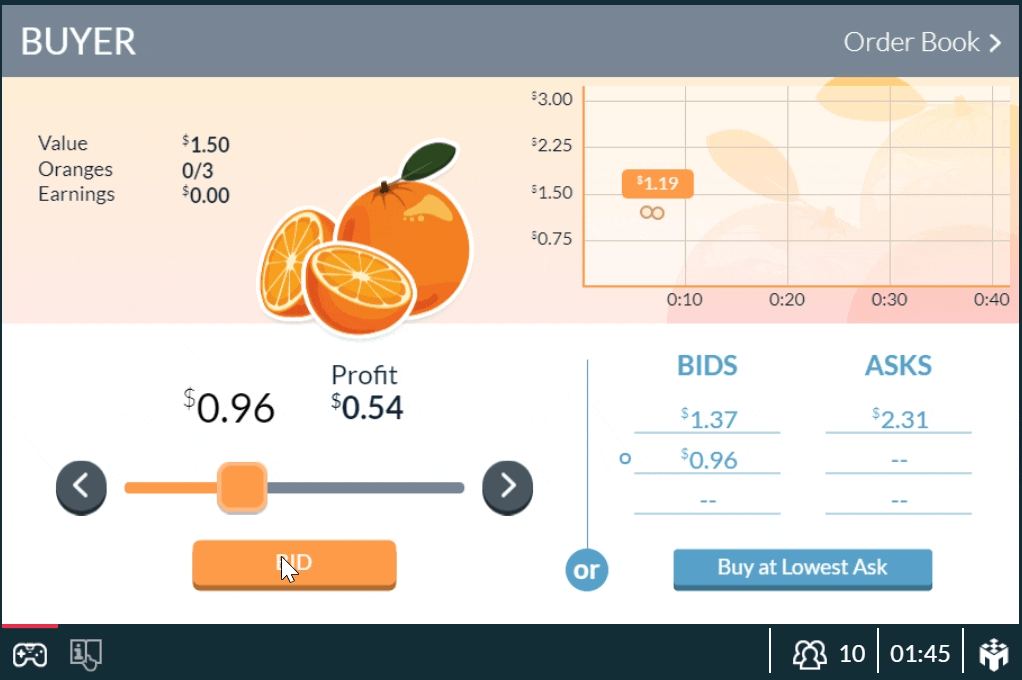Incorporating games into your high school economics class can be a fun way to explore basic economic topics with your students. Gamifying your course content gives students a memorable connection between abstract theory and real life examples (especially for first time econ students). As a high school instructor, you can shift the conversation from “Why would they do that?” to “Why did you do that?”
From Supply & Demand to Perfect Competition, MobLab’s library of content can be easily mapped to your syllabus. Let’s explore a few games to get you started!
Cover the foundational concept of Supply & Demand with our Competitive Market game:
In this game, MobLab divides economics students into markets made up of buyers and sellers. Sellers are given a number of oranges with an increasing cost schedule which they need to sell at the market. Buyers are present to purchase these delicious oranges with a diminishing value schedule. Students seek payoffs from the experiment by either selling above cost, or buying below their value.
After the trading period has finished and the market has cleared, debrief your students and show how the “invisible hand” brings transactions towards an equilibrium price.

MobLab Teaching Tip 1: Use this game (and others) before teaching the theory! Self-interested individuals seeking payoffs will generally bring the market towards equilibrium.
MobLab Teaching Tip 2: Play this game again when covering other market concepts such as price floors & ceilings!
Perfect Competition can be confusing to many first time econ learners…bring it into a relatable context with the Production: Entry, Exit game.
Students assume the role of a rideshare driver. Each round, each student first chooses whether to drive that day, which determines that round’s market price. Faced with increasing marginal costs, each driver chooses the number of hours to drive. If many students elect to drive on a particular day, the market price for an hour of driving decreases! Students experience the number of drivers who enter and exit the market on a round to round basis.

Within the context of the rideshare industry, students experience marginal costs, revenue, and market entry decisions in a digestible way!
MobLab Teaching Tip 3: Use MobLab’s scoreboard feature after running games to show the top scores. This is a great opportunity to not only congratulate them on the money ‘earned’ while driving, but is a point to dig deeper on their decisions!
MobLab Teaching Tip 4: Combine these games with a survey question or two after the game, to give you better understanding of student comprehension.
Below are a few other games that may work well in your high school economics class!Comparative Advantage - Students learn about opportunity costs & the benefits of trade as food trucks. Check out our recent blog post. Push & Pull - Introduce the topic of the prisoner’s dilemma & dominant strategy. Commons: Fishery - Where did all of the fish go?? Students experience the tragedy of the commons in this fun fishing game.
Would you like to learn more? If you already have an account, you can check out all of our games in our game library. Don’t have an account? Create one! It’s commitment free and gives you access to all MobLab materials. Here is the link to sign up or if you prefer to meet one-on-one, schedule a time with us here.
From Supply & Demand to Perfect Competition, MobLab’s library of content can be easily mapped to your syllabus. Let’s explore a few games to get you started!
Cover the foundational concept of Supply & Demand with our Competitive Market game:
In this game, MobLab divides economics students into markets made up of buyers and sellers. Sellers are given a number of oranges with an increasing cost schedule which they need to sell at the market. Buyers are present to purchase these delicious oranges with a diminishing value schedule. Students seek payoffs from the experiment by either selling above cost, or buying below their value.
After the trading period has finished and the market has cleared, debrief your students and show how the “invisible hand” brings transactions towards an equilibrium price.

MobLab Teaching Tip 1: Use this game (and others) before teaching the theory! Self-interested individuals seeking payoffs will generally bring the market towards equilibrium.
MobLab Teaching Tip 2: Play this game again when covering other market concepts such as price floors & ceilings!
Perfect Competition can be confusing to many first time econ learners…bring it into a relatable context with the Production: Entry, Exit game.
Students assume the role of a rideshare driver. Each round, each student first chooses whether to drive that day, which determines that round’s market price. Faced with increasing marginal costs, each driver chooses the number of hours to drive. If many students elect to drive on a particular day, the market price for an hour of driving decreases! Students experience the number of drivers who enter and exit the market on a round to round basis.

Within the context of the rideshare industry, students experience marginal costs, revenue, and market entry decisions in a digestible way!
MobLab Teaching Tip 3: Use MobLab’s scoreboard feature after running games to show the top scores. This is a great opportunity to not only congratulate them on the money ‘earned’ while driving, but is a point to dig deeper on their decisions!
MobLab Teaching Tip 4: Combine these games with a survey question or two after the game, to give you better understanding of student comprehension.
Below are a few other games that may work well in your high school economics class!
Would you like to learn more? If you already have an account, you can check out all of our games in our game library. Don’t have an account? Create one! It’s commitment free and gives you access to all MobLab materials. Here is the link to sign up or if you prefer to meet one-on-one, schedule a time with us here.

